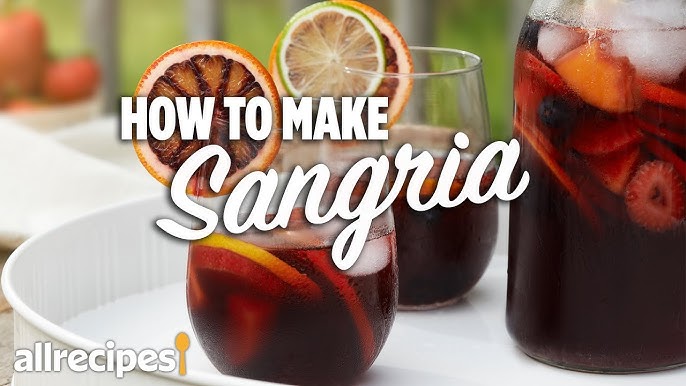Sangria Recipe: There’s something magical about sipping on a refreshing glass of Sangria, especially on a warm day. This fruity, wine-based punch has roots in Spain but has become a global favorite for gatherings, parties, and lazy afternoons. The beauty of Sangria is that it’s easy to make, highly customizable, and perfect for sharing.
In this article, I’ll walk you through a step-by-step guide on how to make the perfect Sangria at home, complete with tips for variations and pairings.
What Is Sangria?
Sangria is a traditional Spanish beverage made by mixing wine with fresh fruits, sweeteners, and sometimes a touch of brandy. It’s known for its vibrant color and refreshing taste, ideal for social occasions. While it originated in Spain, its appeal has spread across the world, with each culture adding its own twist.
Why Make Sangria at Home?
There are several reasons to whip up a pitcher of Sangria at home. First, it allows you to control the sweetness and alcohol content to match your taste. Plus, it’s a cost-effective way to enjoy a premium-tasting drink without splurging on expensive cocktails. Lastly, making Sangria is fun—you can experiment with different fruits, wines, and flavors to create something unique every time.
Ingredients Needed for a Perfect Sangria
Base Ingredients
- Wine: Red wine is the traditional choice, but white or rosé can work too.
- Fruits: Oranges, lemons, limes, berries, apples, and peaches are popular picks.
- Sweeteners: Sugar, honey, or fruit juice add a pleasant sweetness.
Optional Ingredients for Extra Flavor
- Brandy or Rum: A splash of spirits boosts the richness.
- Cinnamon or Mint: These spices give it a refreshing, aromatic touch.
Choosing the Right Wine for Sangria
You don’t need to buy an expensive bottle of wine. In fact, a reasonably priced dry wine works best since the added fruits and sweeteners balance the flavors. For red Sangria, consider using wines like Merlot or Rioja. For white Sangria, opt for a crisp wine like Sauvignon Blanc.
Tools You’ll Need
- Knife and Cutting Board: Essential for slicing fruits.
- Pitcher or Bowl: To mix and store the Sangria.
- Stirrer or Ladle: To blend the ingredients evenly.
Step-by-Step Guide to Making Sangria
Step 1: Select Your Wine
Pick a wine that you enjoy drinking. If you prefer something bold, go with red wine. For a lighter, fruitier version, use white wine.
Step 2: Prepare the Fruits
Cut fruits into slices or wedges. You can also squeeze some of the citrus fruits to release extra juice and intensify the flavors.
Step 3: Add Spirits and Sweeteners
Pour in a bit of brandy or rum if you like your Sangria with a punch. Sweeten the mixture with sugar, honey, or orange juice.
Step 4: Combine All Ingredients
In a large pitcher, mix the wine, fruits, and any spirits or sweeteners you’ve added. Give everything a good stir to combine the flavors.
Step 5: Chill the Sangria
Place the pitcher in the fridge for at least 2 hours. The longer it chills, the better the flavors will meld.
Step 6: Serve and Garnish
Before serving, add ice cubes to the glass. You can also garnish with a cinnamon stick or mint leaves for an extra touch of flair.
Sangria Variations to Try
White Sangria
This version swaps red wine for white wine and uses tropical fruits like pineapple and mango.
Sparkling Sangria
Add a splash of soda or sparkling wine for a bubbly twist. It’s perfect for celebrations.
Non-Alcoholic Sangria
Use grape or cranberry juice instead of wine to create a kid-friendly mocktail.
Tips for the Best Sangria Experience
- Adjust Sweetness Levels: Taste as you go. If it’s too sweet, balance it with a bit of citrus.
- What to Serve with Sangria: Tapas, cheese platters, or grilled dishes complement Sangria perfectly.
FAQs about Sangria Recipe
1. What type of wine is best for making sangria?
For traditional red sangria, a dry, fruity red wine is ideal. Popular choices include Tempranillo, Garnacha, or other Spanish reds. For a lighter version, like white sangria, opt for a crisp white wine such as Sauvignon Blanc or Pinot Grigio.
2. What fruits should I include in sangria?
The beauty of sangria lies in its versatility. Common fruits include oranges, lemons, limes, apples, and berries. Feel free to experiment with seasonal fruits like peaches or melons to add a unique twist to your recipe.
3. How long should I let my sangria sit before serving?
Allow your sangria to sit in the refrigerator for at least 4 hours, though overnight is best. This waiting period helps the flavors of the fruit and wine to meld together, resulting in a richer, more cohesive taste.
4. Can I make sangria without alcohol?
Absolutely! For a non-alcoholic version, replace the wine with sparkling grape juice or a mix of fruit juices like apple and orange, then follow the rest of the recipe as usual.
5. What is the best way to serve sangria?
Serve sangria chilled or with a few ice cubes. Garnish with fresh fruit slices, and consider a splash of sparkling water or soda right before serving to add a refreshing fizz.
6. How can I sweeten my sangria?
If you prefer a sweeter sangria, you can add a splash of simple syrup, honey, or even a flavored liqueur. Adjust the sweetness according to your taste, and remember that the fruits will also add natural sugars to the drink.
Conclusion
Making Sangria at home is all about creativity and fun. With the right combination of wine, fruits, and optional spirits, you can craft a delicious drink that’s perfect for any occasion. Whether you prefer a classic red Sangria or a bubbly sparkling version, the possibilities are endless. So, grab your favorite wine, slice up some fruits, and enjoy!
References
For additional details and to enhance your understanding of creating a delightful Sangria recipe, consider consulting these reputable sources. Each provides valuable insights that can help ensure your Sangria turns out flavorful and authentic:
- Wine Enthusiast: Explore an array of expert advice on selecting the perfect wine for your Sangria, which is crucial for achieving the right balance of flavors. Visit Wine Enthusiast.
- Epicurious: Offers a comprehensive guide, including variations on the traditional Sangria recipe to cater to all tastes. Whether you’re looking for a classic taste or something more adventurous, their tips are invaluable. Check out Epicurious.
- Food & Wine: Provides insights into the different components that make up Sangria, including recommendations for fruits, spirits, and proportions. Their detailed descriptions can help you master the art of Sangria making. Read more at Food & Wine.
These sources are trusted for their thorough research and expertise in culinary arts, making them excellent references for anyone looking to perfect their Sangria recipe.



